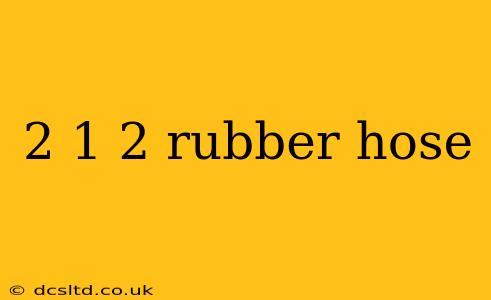Decoding the Mystery of "2 1 2 Rubber Hose": Sizes, Applications, and More
The seemingly simple phrase "2 1 2 rubber hose" actually hides a world of specifications and applications. Understanding what this designation means is crucial for selecting the right hose for your needs. This guide will break down the meaning, explore common uses, and answer frequently asked questions surrounding this type of rubber hose.
What Does "2 1 2 Rubber Hose" Mean?
The "2 1 2" likely refers to the hose's nominal inside diameter (ID), expressed in inches. This means the inside diameter of the hose is approximately 2 1/2 inches. However, it's crucial to note that this is a nominal measurement, and the actual inside diameter might vary slightly depending on the manufacturer and specific hose construction. Always check the manufacturer's specifications for precise dimensions.
This measurement is critical because it determines the hose's capacity to carry fluids or other materials. A larger ID allows for a higher flow rate.
What are the Common Applications of a 2 1/2 Inch Rubber Hose?
A 2 1/2 inch rubber hose, due to its significant diameter, is typically used in applications requiring high flow rates and the transport of larger volumes. Some common uses include:
- Industrial applications: Transferring liquids or slurries in manufacturing processes, often in larger-scale operations.
- Agricultural irrigation: Delivering water to crops over longer distances or to areas requiring a high volume of water.
- Firefighting: While specialized fire hoses often have different specifications, a 2 1/2 inch hose could be used in certain scenarios or for specific applications. (Note: This is not a recommendation for firefighting without proper training and equipment.)
- Construction and demolition: Transferring water or other materials during construction or demolition projects.
- Marine applications: Used in larger boats for bilge pumping, transferring water, or other fluid handling tasks.
What are the Different Types of 2 1/2 Inch Rubber Hoses?
The type of rubber used and the hose's construction greatly impact its performance and suitability for various tasks. Different rubbers offer varying levels of flexibility, durability, chemical resistance, and temperature tolerance. Some examples of rubber types used in hoses include:
- EPDM (Ethylene Propylene Diene Monomer): Known for its excellent weather resistance, ozone resistance, and good heat resistance. Often used in outdoor applications.
- Neoprene: Offers good resistance to oils, fuels, and chemicals, making it suitable for industrial applications.
- Silicone: High temperature resistance and flexibility, useful in high-heat environments.
- Natural Rubber: Good flexibility but less resistant to chemicals and aging compared to other synthetic rubbers.
The hose's reinforcement also plays a significant role. This might include multiple layers of fabric or wire to enhance strength and prevent collapsing under pressure.
What Factors Should I Consider When Choosing a 2 1/2 Inch Rubber Hose?
Selecting the right 2 1/2 inch rubber hose depends on several factors:
- Fluid Compatibility: The hose must be compatible with the fluid being transported to avoid damage or contamination.
- Working Pressure: The hose must be rated for the pressure it will experience during operation.
- Temperature Range: The hose needs to withstand the temperatures it will encounter during use.
- Length and Flexibility: Choose a length appropriate for your application and a level of flexibility that suits the installation environment.
How Long Does a 2 1/2 Inch Rubber Hose Typically Last?
The lifespan of a 2 1/2 inch rubber hose depends significantly on the type of rubber, the hose's construction, and the conditions under which it's used. Proper maintenance and storage can prolong its life. However, regular inspection for wear and tear is crucial for safety and to prevent leaks or failures. Check for cracks, abrasions, and bulges.
This detailed explanation should help clarify the meaning and application of "2 1/2 rubber hose". Remember to always consult the manufacturer's specifications for precise details and safety guidelines before using any rubber hose.
